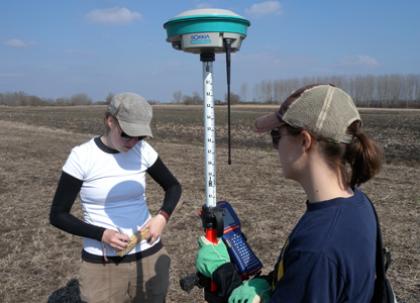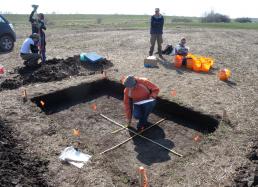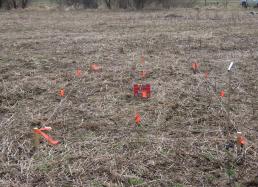1: "Az Első Nap" (The First Day)
Today is our first official day of the 2011 field season of the Körös Regional Archaeological Project. After giving a talk at an international conference in Kiel, Germany, Attila Gyucha, Rick Yerkes, and I arrived in Hungary to attend a conference of the Hungarian Prehistoric Society. Both of these were excellent opportunities to meet with colleagues to learn about their research, and also to tell them about our exciting results from last season. At the conference, we met up with our collaborators, Paul Duffy and Rod Salisbury.
Last Friday, while in Budapest, we picked up the 4x4 vehicles and two of the graduate students, including Dani Riebe, who brought much of our equipment over from the United States. Since then, the team has gradually been coming together. In addition to a couple of Hungarian archaeologists, who joined us on Saturday, a big group of American graduate and undergraduate students arrived by train in Békéscsaba yesterday afternoon. We’re now over twenty people, and we’ll only get bigger from here on out.
Having such a large crew in a small farming town like Vésztő poses interesting challenges. When we had large crews during the earlier phases of our project, we were opening big excavations. We came in the summer, when the weather was not only more predictable, but the timing was also more convenient for students and scholars from the United States, who’re frequently locked into academic schedules. Then, with the gracious support of the mayor, we were permitted to stay in the elementary school, where we had a huge amount of space for working and lodging.
In the current phase of our project, however, we’re doing a lot of surface survey in an attempt to figure out the nature of the complex settlement at Szeghalom-Kovácshalom. Surface surveys are conducted during the spring season because much of the Great Hungarian Plain, which is not unlike the Midwestern United States, is under cultivation with crops such as sunflowers, corn, alfalfa, and wheat.
Surveying in the summer is not an option because, as the farmers in the Midwest say, “the corn is knee high by July.” Since we can’t see the ground, surface surveying is useless, which is we have to come in the spring or the fall. The problem with working here during those times of the year is that school is in session, and I don’t think teachers would appreciate having almost thirty archaeologists covered with mud using their classrooms as bedrooms!
Combined with the fact that Vésztő is not a major center for tourism—despite the amazing nearby site of Vésztő-Mágor—it’s hard to find a place to put everybody. Fortunately, the place we stayed in last year was still available for this year, but the maximum it can sleep is eighteen. Plus, we’ll require much more lab space to process the various finds and materials we’ll be collecting this year.
As opposed to last year, when we were doing primarily surface survey, magnetometry, and topography with some sediment coring, this year we plan to expand the project to include test excavations and intensive sediment coring, as well as a suite of other geophysical and geochemical techniques. Plus, we have nearly 30,000 pieces of ceramics and other materials to analyze from last year.
This morning, we took the crew (most of whom were very jetlagged) out to the site. We needed to re-establish the topographic grid we used last year, to make sure that the data we collect this time is taken from the exact same locations where we collected data last year (see above photo.) We also needed to set in points for the test excavation trenches and the intensive survey units, which will be based on the work that we conducted last year.
We have decided to begin with two 2x3-m test excavation trenches. One is positioned to investigate a longhouse in the eastern part of the site (see Photo #1 below.) The other is designed to explore a smaller house on the intensively occupied area in the south (see Photo #2 below.) We hope not only to get materials and artifacts that will tell us something about their relative chronology and function, but also to ground truth the magnetic anomalies that Apostolos Sarris and Nikos Papadopoulos identified last year. We also started intensive surface collections around one of the outlying daub concentrations.
It has been raining since we arrived. This makes it very difficult to get out to the field, because almost all the soil in this part of the country is a very fine-grained sediment that immediately turns into thick mud that sticks to your boots and makes you feel like you’re walking with lead stilts glued to the bottom of your feet.
Fortunately, with the help of some local friends, we were able to get out to the site. We carried out a lot of the equipment that we’ll need for the coring and the excavations. We also managed to re-establish the topographic grid (after only a little confusion and some cursing) using the GPS. Then we set out the two test excavation trenches, as well as many of the squares where we’ll surface collect.
All in all, it was a good first day! The weather looks like it may be turning, too. We certainly hope it does, because the Greek geophysical team arrives on Thursday and we need to work ahead of them—to lay out the grid and conduct the surface collections before they conduct the geophysical survey.
We’re very excited about the prospects of our findings this season, and we look forward to having you join us along the way!
More soon,
Bill





